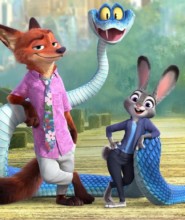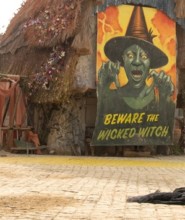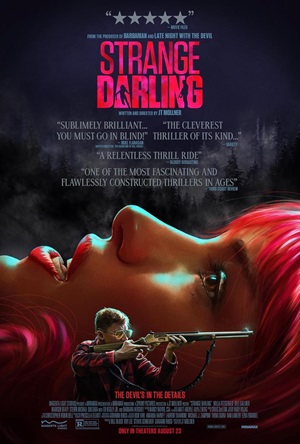
Deceptively Beautiful Strange Darling Explores a Cruel World of Ruthless Malevolence
A woman (Willa Fitzgerald) embarks on a one-night stand with a softspoken man (Kyle Gallner) she meets in a bar, seductively bantering in his car as they contemplate getting a hotel room. Fast-forward to the next morning. This same woman runs across an open field as if her life depended on it, ultimately stumbling upon the home of an eccentric pair of isolationists (Ed Begley Jr., Barbara Hershey) whom she begs for help.
Written and directed by JT Mollner (Outlaws and Angels), the gorgeously shot psychological thriller Strange Darling uses a nonlinear structure to shake up what otherwise would be a familiar tale of subterfuge, eroticism, and terror. Think of something like Jonathan Demme’s 1986 favorite Something Wild and you’ll get a general idea of what I mean. Two people meet, sparks fly, and they subsequently embark on a sexual adventure only for things to turn out violently lethal in the light of a new day. The main twist? Unlike Demme’s cult classic, no third party is responsible for all of the carnage.
Mollner plays it coy, and even if the characters Fitzgerald and Gallner portray are accurately referred to in the credits as “The Lady” and “The Demon,” those definitions are not going to be exactly the ones the audience would normally anticipate. It’s a ghoulish game of cat and mouse or hunter and prey. Everything builds to a playfully macabre ending that, if they see the movie, would likely have Joel and Ethan Coen sitting in the back of the theater quietly chuckling with knowing grins on their faces as they give one another a high-five.
What does all that mean in plain English? Basically, it says that I can’t talk too much about what happens because, if I do, it would ruin all of the film’s malevolent twists and turns. While none of what Mollner is doing is particularly subtle, it’s clear he, his cast, and his creative team are having a blast doing it all the same. Each chapter of the story may be told out of order, but that does not mean there aren’t several clues that lead to the hows and whys deftly delivered along the way. Mollner makes certain that the viewer is in on the joke.
Would the film work without its nonlinear structure? I couldn’t stop pondering that question after I left the theater. If presented in a straightforward manner, the reveal would likely come too soon. The clues that allow the audience to play detective wouldn’t exist. The physical and mental games Fitzgerald and Gallner play with one another wouldn’t have any resonance.
At least, that’s just some of what I suspect my overall reaction to Mollner’s grindhouse chiller would have been. As the director did not go down that path, I’ll obviously never know. It’s still hard not to think that, without this narrative trick, everything presented in this story would have fallen catastrophically flat. Mollner’s playing fast and loose with the audience’s emotions, and as much as I admire his chutzpah, a part of me is still slightly annoyed at the mischievous superciliousness of what he’s doing.
But only slightly. I found it all far too entertaining for my minor frustrations to grow into anything lasting. Shot by actor Giovanni Ribisi (who is also one of the picture’s producers) on 35mm film, there is a kinetically gorgeous mystery to the visuals that got under my skin. He creates an immersive dimensionality to every scene that’s hypnotic, almost as if there is something concealed just outside the frame that, once revealed, will have a massive impact on all that’s happening.
The acting is also exemplary. Gallner does a superb job of playing on a viewer’s expectations for his character, his angry obsessivity becoming oddly and uncomfortably understandable as events focus into disquieting clarity. While I’m still prone to his dexterously lithe work in the criminally underseen Dinner in America, make no mistake, this is some of the best work of Gallner’s career.
That’s nothing compared with what Fitzgerald is up to. This is an eye-opening performance that by all rights should make her a household name and an above-the-title star. The actor has to keep track of all of The Lady’s emotional and physical permutations, presenting them in a manner that feels authentically natural and not the brainchild of a clever screenwriter. Fitzgerald does this with delectable ease, bringing a playful sensuality and a deceptively agile physicality to her character that’s intoxicating.
As terrific as all that is, I still can’t say I was fully sold on the film when it ended. But it’s one of the few motion pictures I’ve seen this year where several members of my packed audience lingered in the lobby afterward hotly discussing (pros, cons, all of it) what they’d just watched. I love that. Better, as I walked home, I couldn’t help but happily smile myself. So many moments stuck with me, and I found several images had been burned into my brain. There is a beauteously ruthless toxicity to Mollner’s cruel world that’s honestly glorious, and for those that get on his wavelength, Strange Darling is a great deal of malicious fun.
Film Rating: 3½ (out of 4)








